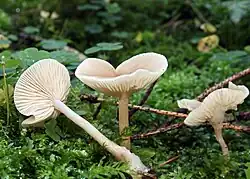Clitocybe fragrans
| Clitocybe fragrans | |
|---|---|

| |
| Scientific classification | |
| Kingdom: | Fungi |
| Division: | Basidiomycota |
| Class: | Agaricomycetes |
| Order: | Agaricales |
| Family: | Clitocybaceae |
| Genus: | Clitocybe |
| Species: | C. fragrans
|
| Binomial name | |
| Clitocybe fragrans | |
| Synonyms[1] | |
| |
| Clitocybe fragrans | |
|---|---|
| Gills on hymenium | |
| Cap is flat | |
| Hymenium is decurrent | |
| Stipe is bare | |
| Spore print is white | |
| Ecology is mycorrhizal | |
| Edibility is edible but not recommended | |
Clitocybe fragrans is a species of mushroom with several lookalikes, some of which are poisonous.
Description
It is a white mushroom. The cap ranges from 1–5 centimetres (1⁄2–2 in) in diameter.[2] The gills are somewhat close.[3] The stem is 2–6 cm (3⁄4–2+3⁄8 in) long and 2–5 millimetres (1⁄16–3⁄16 in) wide.[2] It has a fragrant odour resembling aniseed.[3] The spore print is whitish.[3]
Similar species
Within its genus, it notably resembles the deadly Clitocybe dealbata (which lacks the anise odour)[2] and the edible Clitocybe odora (the aniseed toadstool).[2]
Other lookalikes lacking the anise scent can be found especially in the genera Leucocybe, Rhizocybe, Singerocybe.[3]
Distribution and habitat
It can be found throughout Europe growing in broadleaf woodland, from August to December.[4] It can also be found in North America's West Coast and Pacific Northwest regions under conifers, from October to February.[3]
Edibility
While edible, some guides caution against its consumption as it can be confused with deadly poisonous species.[5] It can be preserved by drying.[4]
References
- ^ "Synonymy: Clitocybe fragrans (With.) P. Kumm". Index Fungorum. CAB International. Retrieved 2012-12-15.
- ^ a b c d Davis, R. Michael; Sommer, Robert; Menge, John A. (2012). Field Guide to Mushrooms of Western North America. Berkeley: University of California Press. pp. 148–149. ISBN 978-0-520-95360-4. OCLC 797915861.
- ^ a b c d e Audubon (2023). Mushrooms of North America. Knopf. p. 497. ISBN 978-0-593-31998-7.
- ^ a b Francis-Baker, Tiffany (2021). Concise Foraging Guide. The Wildlife Trusts. London: Bloomsbury. p. 136. ISBN 978-1-4729-8474-6.
- ^ Phillips, Roger (2010). Mushrooms and Other Fungi of North America. Buffalo, NY: Firefly Books. p. 61. ISBN 978-1-55407-651-2.
External links